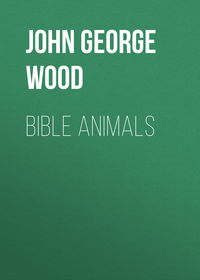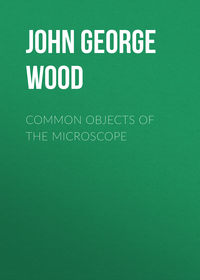 полная версия
полная версияThe Common Objects of the Country
It will be remembered that in mentioning the Green Oak Moth, the Destroying Empis was also noticed. One of these flies is shown on plate J, fig. 5, with the poor Tortrix in its grasp. Plate K, fig. 1, shows its foot, and fig. 3 its head, together with its long beak.
The beak of this fly somewhat reminds one of the corresponding portion of the Gnat, which insect is not itself depicted, though on plate F, fig. 10, is shown the wonderful little egg-boat which it makes. This insect glues together its eggs in such a manner that they are formed into a true lifeboat, which cannot be upset, or sunk, or filled with water, but floats securely on the surface until the young are hatched. That object accomplished, the gnat-larvæ tumble into the water, and there undergo their transformation.
The last of the two-winged flies that will be mentioned is the common Daddy Long Legs, or Crane-fly, which seems to set such little value on its limbs. It is a very injurious insect in its larval state, feeding on roots, and doing great damage. Plate H, fig. 1, shows a very pretty species, covered with yellow rings.
Every one must have noticed the beautiful and active insects that are with great truth called Dragon-flies. Their habits and peculiarities would demand a volume; and here they can but be mentioned. Plate F, fig. 6, shows the common Flat Dragon-fly, that may be seen chasing and following flies of all sizes, and even butterflies. Fig. 8 is the elegant Demoiselle, the male of which is shown here, with its dark purple spots on the wings and dark blue body. The female is of a uniform green. Its larva is shown at fig. 8 a, where the singular leafy gills may be seen at the end of its tail. Fig. 7 shows another very common Dragon-fly, very thin and ringed with blue circlets.
On the same plate, fig. 12, may be seen several varieties of the objects known to fishermen as “Caddis” cases. These are residences built by the larva of the common Caddis, or Stone-fly, which is represented on the same plate, fig. 9.
Still keeping to plate F, and referring to fig. 1, is seen the horrid-looking Water-scorpion, a creature which, though it does not sting, has much of the scorpion nature, and so bites. Fig. 1 a shows the same insect as it appears when flying.
At fig. 3 is seen the Water Boatman, so called because it lies on its back, which is ridged like the keel of a boat, and then rows itself about by means of its middle pair of legs, which closely resemble oars.
Fig. 5 shows a very curious object which is common enough on the margin of pools, and runs on the surface of the water as if it were dry land. When alarmed, it shuts up all its legs, and looks just like a piece of dry grass or thin stick.
Another insect much resembling it, is the common Gerris, seen on plate I, fig. 6. It may be seen on every pond or still water, running over its surface, and is furnished with wings wherewith it can fly to great distances. I have found specimens on the tops of hills, far from any water, and hiding under stones out of the sun’s heat. Fig. 1 shows the common May-fly.
All gardeners have been annoyed with the curious production called the Cuckoo-spit. This proceeds from the larva of one of the hoppers, and on removing the frothy substance, the little soft, greenish insect may be found within. The perfect insect is shown on plate C, fig. 1 a, and the exudation itself at fig. 1.
There is another hopper seen on plate B, fig. 2, called from its colour the Scarlet Hopper. It is common enough on ferns, and may be found chiefly in the open spots of forests where ferns abound.
On plate J, fig. 7 a, is the common Green Grasshopper, as it appears when standing; and on fig. 7, the same insect as it appears when using its wings.
The common Earwig, plate I, fig. 8, is introduced for the purpose of showing the very beautiful wing which this insect possesses, and which is seen expanded at fig. 8 a.
The very lovely, though ill-odoured, Lace-wing Fly is shown on plate J, fig. 4, and its very remarkable eggs at 4 a. Each egg is placed at the end of a footstalk, whereby it is kept out of the reach of certain predacious insects.
Various shells are drawn on one or two of the plates, but there is not space for any description. Their names may be found on the Index to Plates. Plate G contains certain fungi and mosses. Fig. 1 is that peculiar plant which reindeer scrape from under the snow in the winter time. Fig. 2 was once dreaded by rustics as “Witch’s butter”. Fig. 6 shows the curious Earth-star, chiefly remarkable for its resemblance to the marine Star-fish.
INDEX
A.Adela, 153.
Admiral Butterfly, 156.
Armadillo, 87.
B.Bat, 4.
Bedeguar, 172.
Bird-nest moss, 176.
Blind-worm, 45.
Blue Butterfly, 160.
Brimstone Butterfly, 163.
Brimstone Moth, 147.
Buff-tip Moth, 132.
Burnet Moth, 113.
Burying Beetle, 116.
C.Cabbage Butterfly, 161.
Caddis, 174.
Clear-wing Moth, 149.
Cock-tail Beetle, 166.
Crane-fly, 173.
Cray-fish, 81.
Cuckoo-spit, 175.
Cup Moss, 176.
Cynips, 172.
D.Death-watch, 169.
Drinker Moth, 123.
Dragon-flies, 174.
E.Earwig, 175.
Eft, 65.
Elephant Hawk Moth, 130.
Emperor Moth, 126.
Empis, 140.
F.Field Mouse, 17.
Fire-tail, 172.
Frog, 55.
G.Galls, 171.
Gerris, 175.
Glow-worm, 167.
Gnat Eggs, 173.
Gold-tailed Moth, 133.
Grasshopper, 175.
Ground Beetle, 168.
H.Harvest Mouse, 20.
Hopper, scarlet, 175.
–– Cuckoo, 175.
Hornet, 171.
Hoverer Fly, 172.
Humble-bee, 170.
Hydrometra, 174.
I.Ichneumon, Microgaster, 162.
L.Lace-wing Fly, 176.
Lackey Moth, 143.
Lady-bird, 169.
Lampern, 78.
Lappet Moth, 145.
Leaf Miners, 141.
Lizard, 43.
Long-horn Moths, 152.
M.Magpie Moth, 148.
Mason Bee, 124.
May-fly, 175.
Mole, 34.
Mouse, Field, 17.
–– Harvest, 20.
–– Shrew, 26.
Musk Beetle, 165.
N.Newt, 65.
O.Oak-apples, 172.
Oak Egger-moth, 115.
Oak Moth, 137.
Oil Beetle, 168.
Orange-tip, 161.
P.Peacock Butterfly, 160.
Pill Millepede, 86.
Plume Moths, 150.
Privet Hawk-moth, 130.
Puss Moth, 110.
R.Rat, Water, 21.
Rat-tailed Maggot, 172.
Reindeer Moss, 176.
Rose Beetle, 167.
S.Shrew, 26.
–– Water, 32.
Shrimp, Fresh-water, 85.
Skipjack Beetle, 169.
Snake, 49.
Stag Beetle, 164.
Stickleback, 74.
Sting-fly, 172.
Stone-fly, 174.
Sun Beetle, 168.
T.Tiger Beetle, 165.
–– Moth, 94.
Toad, 59.
Tortoise Beetle, 170.
Turnip Fly, 171.
–– Hopper, 170.
V.Vapourer Moth, 136.
Viper, 48.
Volucella, 171.
W.Watchman Beetle, 167.
Water Scorpion, 174.
–– Boatman, 174.
Weasel, 39.
Weevils, 169.
Whirligig Beetle, 168.
Witch Butter, 176.
Woodlouse, 86.
INDEX TO PLATES
A. (Front)
1. Tubercled Gall on Bramble-stem.
2. Track of Leaf-Miner on Bramble-leaf.
3. Gnat-Clearwing Moth.
4. Buff-tip Moth.
–a. Caterpillar of do.
5. Privet Moth.
–a. Caterpillar of do.
6. Snail (Helix nemoralis).
7. Do. (Helix nemoralis) var.
8. Do. (Helix cantiana).
9. Do. (Helix ericetorum).
10. Do. (Helix lapicida).
11. Shell (Cyclostoma).
12. Do. (Zonites).
13. Do. (Helix caperata).
14. Do. (Pupa).
15. Do. (Clausilia).
B.
1. Green Oak Moth (Tortrix).
2. Scarlet Hopper (Cercopis).
3. Burnet Moth.
–a. Cocoon of do.
4. Puss Moth.
–a. Caterpillar of do.
5. Tiger-Moth (Arctia).
–a. Caterpillar of do.
–b. Cocoon of do.
6. Oak-galls.
7. Watchman Beetle (Geotrupes).
8. Lady-bird (Coccinella).
–a. Larva of do.
C.
1. Cuckoo-spit.
–a. Cuckoo Hopper (Tettigonia).
2. Bedeguar of Rose.
3. Brimstone Moth.
–a. Caterpillar of do.
4. Emperor Moth.
–a. Caterpillar of do.
–b. Cocoon of do.
5. Elephant Hawk-Moth.
–a. Caterpillar of do.
6. Tortoise Beetle (Cassida).
7. Green Weevil.
8. Burying-Beetle (Necrophorus).
9. Twenty-Plume Moth.
10. Green Adela.
11. Rose-Beetle.
D.
1. Blue Butterfly (Alexis).
–a. Do. Wings closed.
–b. Caterpillar of do.
–c. Pupa of do.
2. Orange-tip Butterfly.
3. Vapourer Moth, Male.
–a. Do Female.
4. Red Admiral.
–a. Caterpillar of do.
–b. Pupa of do.
5. Fire-tail (Chrysis).
6. Sun Beetle.
7. Hornet.
8. Tiger Beetle.
–a. Do Flying.
E.
1. Drinker Moth, Male.
–a. Do. Female.
–b. Do. Caterpillar.
–c. Do. Cocoon.
–d. Do. Chrysalis.
–e. Do. Eggs.
2. Humble-bee Fly (Bombyllus).
3. Magpie Moth.
–a. Do. Chrysalis.
–b. Do. Caterpillar.
4 Gold-tailed Moth (Porthesia).
–a. Do. Caterpillar.
5. Stag-Beetle.
F.
1. Water Scorpion.
–a. Do. Flying.
2. Amber Shell (Succinea).
3. Water Boatman.
4. Whirligig Beetle.
5. Hydrometra.
6. Dragon-Fly (Libellula).
7. Do. (Agrion).
8. Do. Demoiselle (Calepteryus).
–a. Do. Larva.
9. Stone-Fly (Phryganea).
10. Eggs of Gnat.
11. Caddis-cases, composed—
a. Of flat stones.
b. Of bark.
c. Of sand.
d. Of grass.
e. Of grass-stems.
f. Of shells.
12. Water shells.
g. Planorbis.
h. Ancylus.
i. Lymnæus.
k. Paludina.
G.
1. Reindeer Moss (Cladonia).
2. Witch-butter (Tremella).
3. Polytrichum.
4. Bird-nest Moss (Nidularia).
5. Xylaria.
6. Earth-star (Geastrum).
–a. Do. closed.
7. Arscyria.
8. Cup-moss (Cenomyce).
9. Scarlet Cup-moss (Peziza).
10. Marchantia.
H.
1. Crane-fly.
2. Mason Bee (Megachile).
3. Ichneumon (Pimpla).
4. Adela Long-horn.
5. Volucella.
6. Sting-fly (Chrysops).
7. Skipjack Beetle (Elater).
8. Peacock Butterfly.
–a. Do. wings closed.
–b. Do. Caterpillar.
9. White-Plume Moth.
10. Red-tailed Humble-Bee.
11. Common do.
12. Cock-tail Beetle (Goërius).
I.
1. May-fly (Ephemera).
2. Scorpion-fly.
3. Brimstone Butterfly.
4. Cabbage White Butterfly.
–a. Do. Caterpillar.
5. Oak Egger-Moth, female.
–a. Do. Cocoon.
6. Gerris.
7. Musk Beetle.
8. Earwig.
–a. Do. flying.
9. Nut Weevil.
J.
1a. Glow-worm, male.
–b. Do. female.
2. Green Saw-fly (Tenthredo).
3. Turnip-fly.
4. Lace-wing Fly.
–a. Eggs of do. on lilac branch.
5. Empis.
–a. Do. killing Oak-moth.
6. Ichneumon (Microgaster) and cocoons.
7. Grasshopper, flying.
–a. Do. walking.
8. Death-watch (Anobium).
9. Hoverer-fly.
–a. Rat-tailed Maggot.
10. Ground Beetle (Carabus).
11. Oil Beetle.
12. Cocoon of Microgaster, magnified.
–a. Microgaster, magnified.
13. Turnip-hopper (Haltica), magnified.
–a. Do. natural size.
14. Cyclops, magnified, showing egg-sacs.
15. Scarlet Spider (Trombidium), magnified.
–a. Do. natural size.
K. Microscopical.
1. Foot of Empis.
2. Pollen—a. Sunflower.
b. Passion Flower.
c. Lily.
3. Head of Empis.
4. Foot of Male Water-Beetle (Dyticus).
5. Trunk of Blue-bottle Fly.
6. Foot of Frog, showing circulation.
7. Petal of Geranium, showing stomata.
8. Battledore Scales of Blue Butterfly.
9. Scale of Fritillary Butterfly.
10. Eye of Butterfly.
11. Hairs of Humble-Bee.
L. Microscopical.
1 and 3. Scales of various Butterflies.
2. Eye of Hemerobius.
4. Wing of Peacock Butterfly.
5. Poppy seeds.
6. Wing-case of Green Weevil.
7. Egg of Red Underwing Moth.
8. – of Small White Butterfly.
9. – of Tortoiseshell Butterfly.
10. – of Lathonia Butterfly.

B

C

D

E

F

G

H

I

J

K

L






